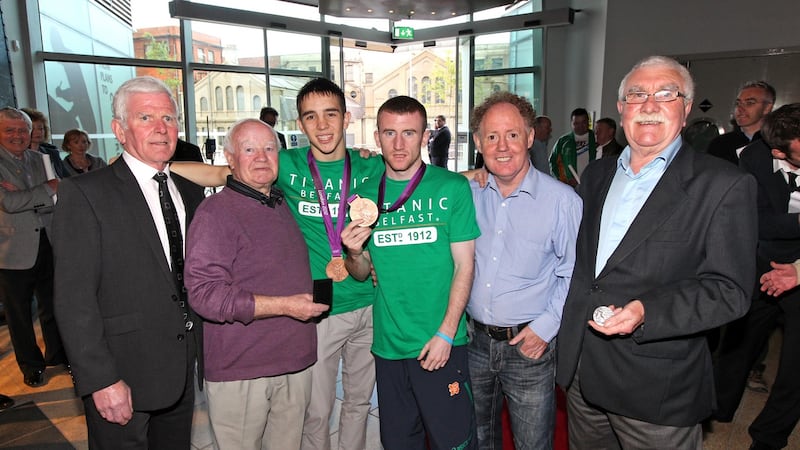There’s a curious homebird trait in people from Belfast. Ask them where they come from and they talk about their locality. Sometimes it can simply be a street name. The sense of a space in a particular part of the city is important and personal.
People don’t come from Belfast. They come from ‘The Falls’ or ‘The Shankill’ or ‘Ballymurphy’ or ‘The Village’ or ‘Ardoyne’. They come from ‘Turf Lodge’, ‘Tigers Bay’, ‘Andersonstown’, ‘Woodvale’ and ‘Sandy Row’.
The labels, they tell much more than the name of a part of town. Not only religion, it’s about pride in the space and the people, communities hotwired to houses and families and finding comfort in things they understand and what shaped them.
Boxer and banjo player with the folk group The Freemen, John McNally lived among the shadows of the chimney stacks and great mills of the 19th century in a slum called the Pound Loney. Part of the lower Falls, it ran almost to the city centre bordering Divis Street and ending about where our school was located on Barrack Street.
In the early 70s during rioting, buses which were the vehicles of choice for burning, were taken off the road and we'd walk home up towards the Falls Road past Divis flats and the pet shops by the baths and library, past Springfield Road and The Royal Victoria Hospital and Beechmount to Rockville Street.
On those walks diversions down Leeson Street or Albert Street took you to the Pound Loney, a tight-knit network of red-bricked terraces.
When McNally was a child the giant mills around the Falls spoke of prosperity, buildings that signified prestige, position and authority. The imposing Hughes Dickson flour mill on Divis Street or Durham Street Mill were familiar parts of the skyline.
McNally’s family had none of that wealth. While the linen industry had provided work for mostly women in the area, there was no similar level of employment for the men. Scarcity and struggle characterised the lives of people who lived there.
Homes were uniformly a front room, a scullery and two bedrooms housing families of five, six, seven, eight and nine children or more. There was heart and warmth in abundance but miserable, unjust poverty.

As he was growing up in the 1930s and 1940s those great industries were already failing, although the buildings remained dotted around the area as monoliths to a changing world. Living in Cinnamon Street, George and Maisie McNally had five daughters and two sons. John was the first-born child. Maisie would have a third son Tomás but she would tragically die from womb cancer soon after giving birth and Tomás would die from an infection after five months of life.
As was tradition in the city where chronic overcrowding was common, two of John’s sisters went to live with their grandmother Rose just around the corner.
When he was seven-years-old in 1939 war was declared. His book 'John McNally – Boxing's forgotten Hero' describes spectators at an Irish League game involving Linfield and Distillery noticing a Junkers scout plane circling high over Windsor Park. A bombing raid that night would kill 1,000 people as mass graves were dug in Milltown and the City cemeteries.
The next day McNally and his family left the lower Falls and with thousands of others migrated up to the Falls Park to sleep in the open playing fields.
He wasn't to know it then but travelling from the Pound Loney to the park his path to a boxing silver medal at the Helsinki Olympics in 1952 would be later walked by others, all of them close and some just streets away.
From the Shankill Wayne McCullough followed in 1992 in Barcelona. So too did Cyprus Street's John Caldwell from McNally's Immaculata club and Ardoyne's Freddie Gilroy in 1956 in Melbourne.
Jim McCourt, Immaculata again, would succeed in Tokyo in 1964 and Hugh Russell in Moscow in 1980. Paddy Barnes from Ardoyne would do it twice, in Beijing and London, and Aidan Walsh in Tokyo last summer.
Less than a mile away in Cavendish Steet just off the Falls Road, Michael Conlan would also bring home a bronze medal from London on his way to becoming the first Irish amateur World Champion.
Throw a quilt over west Belfast and it falls on an Olympic medallist.
But it was McNally, who emerged from a marginalised, forgotten place to make real a dream that when he was just 19 would have been seen as a ludicrous conceit.
"Literally, I found it hard to believe that I, a lad from the Pound Loney, had been picked and was going to travel to the Olympics in Finland, " he said.
Much of the packed rows of housing in the narrow streets were demolished to make way for the sprawling Divis Flats complex built in 1966, which became beset with similar issues of disadvantage that McNally faced.
Most of the Divis development was subsequently demolished in the 1980s to make way for new housing with only Divis Tower remaining. It stands now as a folly and reminder of deprivation across the Falls and Shankill areas.
McNally, like many of the streets where he grew up, has gone. The first Irish boxer to ever win an Olympic boxing medal died this week aged 89; a Belfast bantamweight champion and the Pound Loney coursing rough his veins












